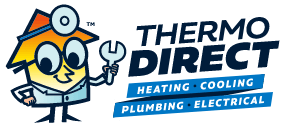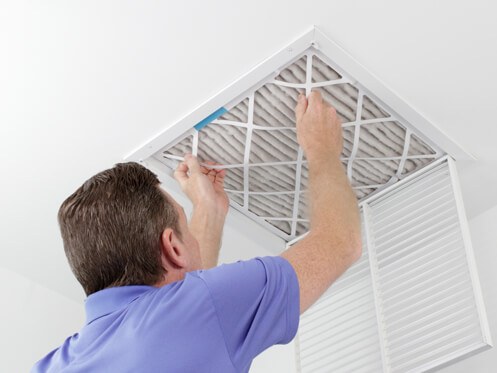Updated April 4, 2024
Keeping your home at a comfortable temperature can also help reduce energy costs if you take the time to improve your home’s airflow efficiency. From installing fans to checking air filters, there are several things you can do to ensure that your home’s airflow works as efficiently as possible. Here are some tips on how to get started.
1. Inspect Your Home’s Ductwork and Vents for Any Leaks or Blockages
Inspecting the ductwork and vents in your home regularly is essential to maximize energy efficiency and improve comfort levels. If there are any leaks, blockages, or holes in either the ductwork or vents, they need to be repaired immediately by a professional technician. Otherwise, conditioned air will escape into the walls or attic of your home instead of going where it needs to go—which means you won’t feel comfortable even if you turn up the thermostat! Additionally, if there is debris blocking a vent, not only will this decrease airflow, but it could also damage the heating/cooling system over time.
Another benefit of regularly inspecting your home’s ductwork and vents is improved indoor air quality. If dirt and dust accumulate in these areas, they can get released into other parts of the house when the HVAC system turns on. Dirt and dust can lead to poor air quality and potential health issues for anyone in the home (especially those with allergies). To reduce these risks, inspect all exposed ductwork every few months for any wear-and-tear (e.g., cracks) that could lead to poor indoor air quality.

It’s recommended that homeowners inspect their homes’ ductwork and vents at least once per year (ideally twice). This helps ensure that any problems are caught early before they can become more significant issues down the road. Additionally, if possible, try not to wait until summer rolls around before scheduling an inspection; many companies offer discounts during cooler months when demand for their services isn’t as high!
2. Investing in an Air Purifier To Help Remove Airborne Contaminants
Several types of air purifiers are available on the market, each designed to address several airborne contaminants. For example, HEPA (High-Efficiency Particulate Air) filters can remove pollen and other particles that trigger allergies or asthma symptoms. Activated carbon filters are great for eliminating odors, while ultraviolet (UV) light can be used to kill bacteria and viruses that may be present in the air. Other types of filters include ionizers, ozone generators, and electrostatic precipitators.
When purchasing an air purifier for your home, you should consult a qualified HVAC technician, who can recommend the best unit based on your specific needs. The installation process is simple; the technician will install the air purifier into the existing ductwork or ventilation system and make sure it is properly connected. Once established, you must maintain it by regularly changing the filter.
The main benefit of having an air purifier in your home is improved indoor air quality, which leads to better overall health for everyone living there. An air purifier can also reduce energy costs by improving airflow throughout the house and reducing dust accumulation on surfaces such as furniture and floors, which can then cause those items to collect dirt more quickly. Finally, having an air purifier installed can extend the life of your HVAC system as it reduces strain on it by removing airborne contaminants before they reach its filter systems which could otherwise clog them up over time.
3. Replacing Old Heating and Cooling Appliances
With any appliance, it’s essential to remember that older models typically aren’t as efficient as their modern counterparts. This is especially true regarding heating and cooling appliances like furnaces, air conditioners, and heat pumps. As these appliances age, they become less efficient due to wear and tear on their parts. Replacing outdated models with newer ones can drastically reduce the energy needed to heat or cool your home.
Replacing your old heating and cooling appliance with a new one may also help improve airflow throughout your house. Many older models may have ductwork or vents that are clogged or inefficiently arranged, which severely hinders air movement through the system. Newer systems are designed to ensure that each room in the house gets the same airflow, ensuring a consistent temperature throughout the entire space. This not only helps improve comfort levels but also helps keep energy costs down.
When shopping for new heating and cooling appliances for your home, there are several things you should consider before making a purchase. First, you want to ensure that the device is certified by an energy rating agency such as Energy Star so you know it meets specific standards for efficiency. It would be best if you also researched different brands to find out which one offers the best warranty coverage for its products.
4. Schedule Regular HVAC Maintenance
When it comes to improving airflow efficiency, there are several ways that regular HVAC maintenance can help. First, a technician will inspect your system for any leaks or blockages that could be causing poor airflow in your home. They may also check for clogged filters or faulty fans and motors, which could prevent proper airflow. If any issues are discovered, they can repair them quickly and efficiently before they become more significant problems.
In addition, a technician will also take steps to ensure that all of your system’s components are working together efficiently by cleaning and calibrating each one as necessary. This includes cleaning out the condenser coils, lubricating moving parts, checking refrigerant levels, and more—all of which contribute to improved airflow efficiency throughout your home.
5. Open Up Your Curtains and Blinds During the Daytime
Allowing the natural light and fresh air into your home can improve your daily quality of life and your home’s air quality. For example, opening up the curtains and blinds during the day creates increased airflow throughout the house. This is because natural wind provides a steady supply of fresh air that will exchange with stale household air as it moves through windows, doors, and vents. These changes to the atmosphere can help reduce pollutants and minimize any smells or odors.
6. Consider Investing in a Whole-House Fan
Investing in a whole-house fan can be invaluable for better air circulation throughout your home. The fan works by sucking in cool air from outside and replacing the stale, warm air indoors. This creates a continuous flow of fresh, comfortable atmosphere that keeps spaces well-ventilated and provides relief from stifling heat. With this replacement of old, stuffy air with cool new air happening instantly, you’ll experience improved comfort immediately. A whole-house fan can also help reduce allergies and pollutants by pushing contaminated air out as it pulls new air in – making for a safer, cleaner environment with more efficient temperature control.
Call Professionals Today!
At Thermo Direct, we provide comprehensive heating, cooling, and electrical services in Raleigh, NC and the surrounding areas. We take great pride in our technicians’ ability to diagnose and resolve any issues you may have. Our customers are our top priority, and we strive for maximum service satisfaction. From minor repairs to complex installation projects, no job is too big or small for us. If you need assistance with any plumbing needs, trust our professionals to deliver fast, reliable service. Call Thermo Direct today to learn more about our services.









